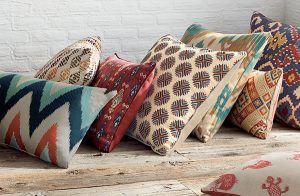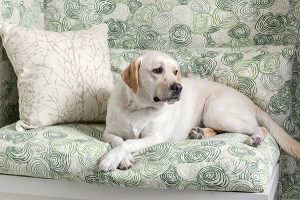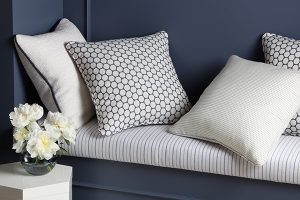Summer is here and our attention has turned to barbecuing with friends, reading books on the deck, patio or sun porch, lounging in a favorite chair, and sipping an iced tea. When we uncover or pull out our furniture to get it ready, yikes, it’s time for an updated look! What about reupholstering with new fabrics? The good news is that the outdoor fabrics available today are not only beautiful but are also practical. The range of patterns and colors are so on-trend that many designers use them indoors too.
Here are some typical differentiating factors between outdoor fabrics; many of these features are often listed directly on the tag of the material:
- mold/mildew resistant
- waterproof
- weather resistant
- UV blockers/Fade resistant
- stain resistant
Outdoor fabrics differ from indoor fabrics in that they are made to be more durable as they undergo a chemical treatment process during manufacturing that ensures they will resist stains, fading and mildew. Outdoor fabrics are woven fibers that differ in strength and durability and application. The primary difference between each type of the most commonly used outdoor fabric lies in the manufacturing process and terminology. COATING OPTIONS: Acrylic coated polyester: Acrylic coats the exterior of a woven fabric, enabling it to withstand rubbing, tearing, poking as well as extreme weather like rain and sun. Vinyl coated or vinyl coated synthetic fiber mesh: Vinyl (PVC) coating is flexible and durable, and when applied to a material it creates a strong, durable, flexible fabric with resistance to multiple elements like stains, sunlight, water and mildew. A vinyl coated material is easy to wipe down and keep clean but can feel like plastic on your skin. Acrylic versus vinyl: Acrylic tends to hold its color better, making it a good choice for areas with strong sun. It is also breathable compared to vinyl and may not feel as hot to the touch. Because it is breathable, water may go through acrylic, so vinyl is better at keeping water off.

Photo courtesy of Kravet.
Waterproof vs. water repellent vs. water resistant: Waterproof means that water cannot penetrate the surface; a waterproof fabric is impervious to water. Water repellent means that water can penetrate the surface, just not very easily. Some materials have an external coating applied, making them water repellent or water resistant. Keep in mind that many of these coatings wear off over time, especially when washed in a machine or even dry cleaned. Canvas and duck cloth: Canvas was traditionally made from hemp or linen. Unless treated, it is not naturally stain, water or mildew resistant. Canvas is also a generic terms used to describe a variety of outdoor fabrics, including polyester, acrylics and blends of these materials. Oil cloth: Oil cloth is generally canvas that has been coated with linseed oil to make it impervious to water. Boiled linseed oil was an easy way to transform cotton canvas into something more weatherproof. Oil cloth is usually a vinyl treated material offered in various thicknesses and used for outdoor tablecloths or placemats. Olefin: A manmade fiber that is typically used along with other fibers to create outdoor fabric blends. It is often used in outdoor furniture. Depending on its chemical structure, olefin may also be referred to as polyethylene or polypropylene. It is a durable fabric that dries quickly and is resistant to weathering, chemicals, stains and mildew
Sunbrella and Soleil: Sunbrella and Soleil are brands at the forefront of outdoor and high performance fabrics. Like many established brands, people often refer to all outdoor fabric as Sunbrella or Soliel. Kravet, a leading fabric icon, calls its indoor/outdoor line Soleil. So many beautiful, durable outdoor fabrics are available, from Kravet and other leading fabric manufacturers like Duralee, Thibaut and Fabricade. Are you ready for a change?









